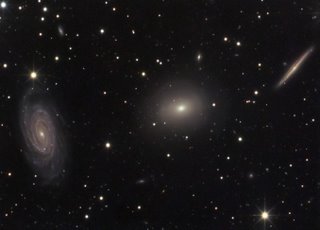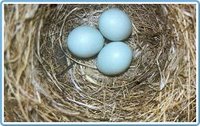
Excellent column!
Olivia Judson - the Wild Side
10:22 pm
Introduction
Genie, I Dream of Planets
Call me a geek, but if a genie appeared before me and offered me a wish, here’s what I’d wish for: detailed descriptions of at least 127 other randomly chosen planets in the galaxy, of which 63 would be home to life.
This may sound greedy (wishes usually do). After all, life on earth holds uncountable mysteries. Here’s one that puzzles me: Why is it that no birds have evolved pregnancy?  Representatives of all the other major groups of backboned animals, from guppies to skinks, have evolved to give birth — why not birds? It would surely be better for an emperor penguin to give birth than to play ice hockey with its egg. Another: Can you alter the odds of conceiving a son or a daughter by altering how often and when you have sex? Tentative evidence suggests you might be able to — but the data are deeply unclear. And how about this: What, apart from thinking, does the sperm whale use its head for?
Representatives of all the other major groups of backboned animals, from guppies to skinks, have evolved to give birth — why not birds? It would surely be better for an emperor penguin to give birth than to play ice hockey with its egg. Another: Can you alter the odds of conceiving a son or a daughter by altering how often and when you have sex? Tentative evidence suggests you might be able to — but the data are deeply unclear. And how about this: What, apart from thinking, does the sperm whale use its head for?  A sperm whale’s head makes up about one third of its body length, and much of the space is taken up by something called the spermaceti organ — but despite much speculation (is it acoustical? A battering ram?), no one knows exactly what this does.
A sperm whale’s head makes up about one third of its body length, and much of the space is taken up by something called the spermaceti organ — but despite much speculation (is it acoustical? A battering ram?), no one knows exactly what this does.
Yet for all the intriguing questions on earth, with only one planet to study, it’s impossible to know which features of life are general features, and which are unique to the earth.  We can’t even be sure what it is about this planet that makes it good at sustaining life: is it the oceans? The motions of the continents? Its magnetic field? Its size? Its moon? Its distance from the sun? Our general situation in a distant and unfashionable section of the galaxy? All of the above? (All have been invoked.) None?
We can’t even be sure what it is about this planet that makes it good at sustaining life: is it the oceans? The motions of the continents? Its magnetic field? Its size? Its moon? Its distance from the sun? Our general situation in a distant and unfashionable section of the galaxy? All of the above? (All have been invoked.) None?
When a volcano erupts in the ocean and forms a new island, at first, there is no life.  But before long, organisms arrive. What happens when a new planet forms? Does life evolve de novo each time? Or does it arrive, by comet or by meteorite? Once life gets going, what happens then? On earth, organisms alter their local environment — and in doing so, open up niches that allow other organisms to flourish. For instance, think of reed beds around a marsh. Over time, the reeds make land: mud and silt collect around their stems, and when they die, their corpses help clog up the water’s edges. Eventually, the lake may disappear; then, the reeds will have sculpted the landscape so drastically they can no longer live there.
But before long, organisms arrive. What happens when a new planet forms? Does life evolve de novo each time? Or does it arrive, by comet or by meteorite? Once life gets going, what happens then? On earth, organisms alter their local environment — and in doing so, open up niches that allow other organisms to flourish. For instance, think of reed beds around a marsh. Over time, the reeds make land: mud and silt collect around their stems, and when they die, their corpses help clog up the water’s edges. Eventually, the lake may disappear; then, the reeds will have sculpted the landscape so drastically they can no longer live there.
Do organisms wreak such changes on the scale of an entire planet? Some evidence suggests they do. We know, for instance, that oxygen was not a significant feature of the earth’s early atmosphere; instead, it has built up over the eons, a deadly waste product given off by organisms that gather energy from the sun.  As oxygen levels have risen, the sorts of creatures living here have changed. It’s even been suggested that the metabolic activities of early organisms helped the formation of the first continents, by altering the chemical composition of rocks. Perhaps drifting continents are an inevitable consequence of life. If we had more planets, we could know.
As oxygen levels have risen, the sorts of creatures living here have changed. It’s even been suggested that the metabolic activities of early organisms helped the formation of the first continents, by altering the chemical composition of rocks. Perhaps drifting continents are an inevitable consequence of life. If we had more planets, we could know.
If we had more planets we could also probe the pace of evolution. On Earth, evolution proceeds surprisingly slowly — yes, slowly. From our experiments in breeding, we know that, in principle, massive changes to an organism’s physique can be effected in a few generations. Take dogs. Thanks to our efforts, the biggest dogs are more than 40 times as large as the smallest, and these changes have been wrought in just a few hundred years. Dogs are far more diverse in size and appearance than any naturally breeding mammal.  Indeed, they are far more diverse than all their relations — the foxes, jackals and wolves — combined. In the days when fancy pigeons were popular, we likewise bred a plethora of birds with plumage more amazing than any worn by a pigeon found in nature. In other words, our breeding programs show the enormous potential for rapid and radical change — yet in nature, such rapid, radical change is rare. It tends to happen either on new islands — Hawaii is home to more than 200 unique species of fruit fly (you may not feel wowed by this news, but you should be) — or after huge wipeouts, such as the extinction of the dinosaurs. Perhaps planets where big disasters are more common have much more rapid evolution.
Indeed, they are far more diverse than all their relations — the foxes, jackals and wolves — combined. In the days when fancy pigeons were popular, we likewise bred a plethora of birds with plumage more amazing than any worn by a pigeon found in nature. In other words, our breeding programs show the enormous potential for rapid and radical change — yet in nature, such rapid, radical change is rare. It tends to happen either on new islands — Hawaii is home to more than 200 unique species of fruit fly (you may not feel wowed by this news, but you should be) — or after huge wipeouts, such as the extinction of the dinosaurs. Perhaps planets where big disasters are more common have much more rapid evolution.
But while we’re waiting for the genie, there are, as I said, plenty of questions at home to occupy the minds of even the most insatiably curious. 
Thus, over the next four weeks, I will explore a variety of subjects, from suggesting experiments to investigate why birds have never evolved pregnancy, to contemplating how we could use technology to resurrect the dodo. But I will start with a matter that I’ve been thinking about a lot recently: the patchwork nature of the genome and the phenomenon of novelty in evolution. Wave your antennae to catch next week’s miniseries of columns in this space: “The Building of a Genome.”
Link to ThisComments (48)


<< Home